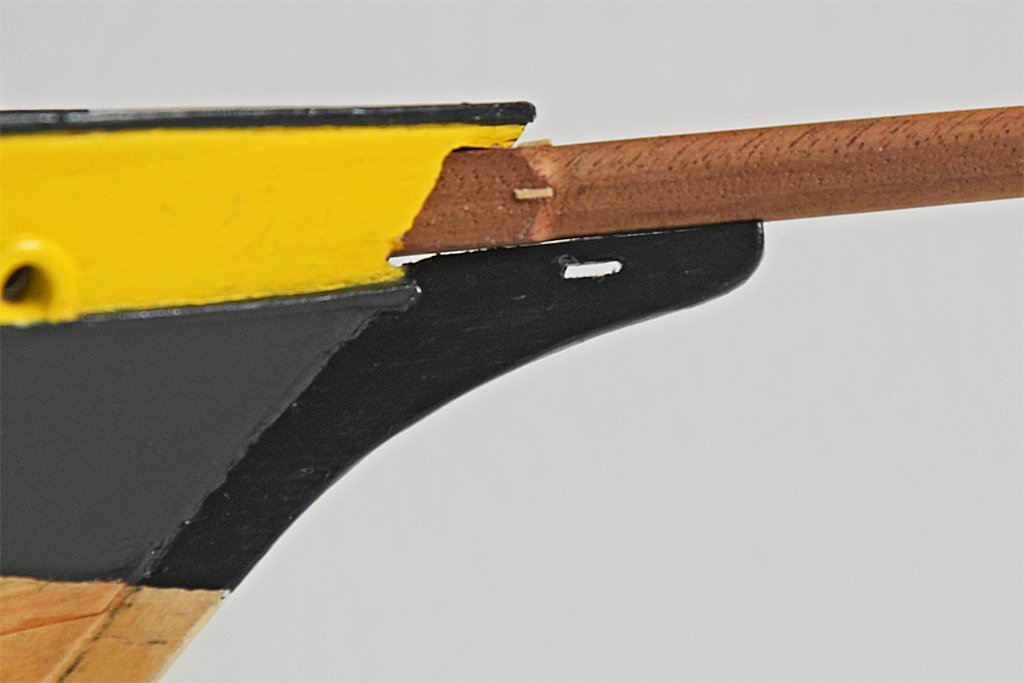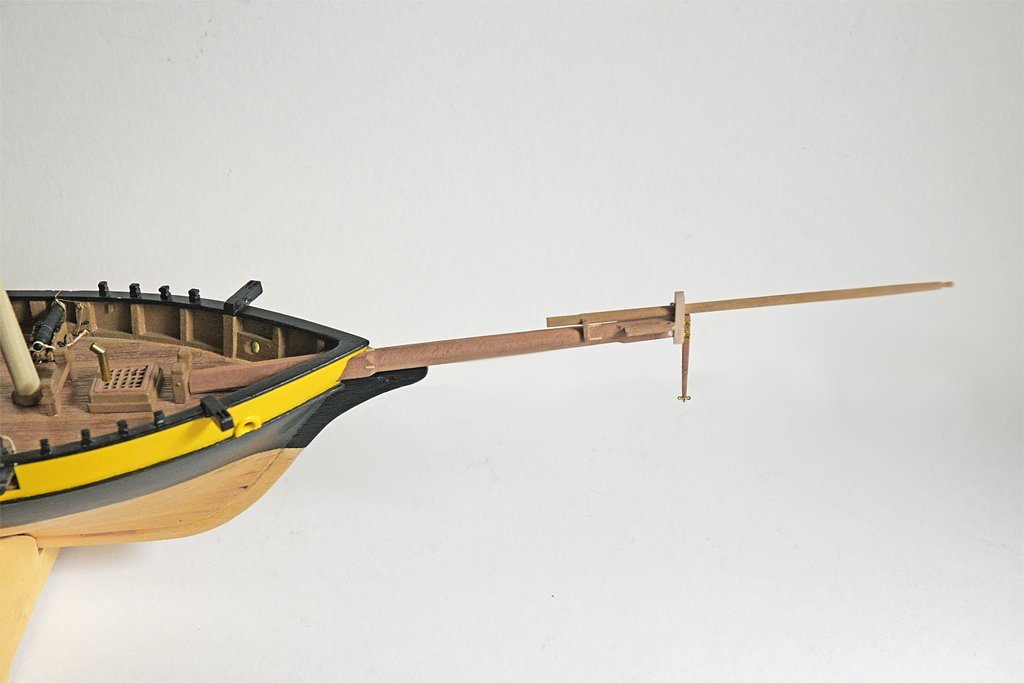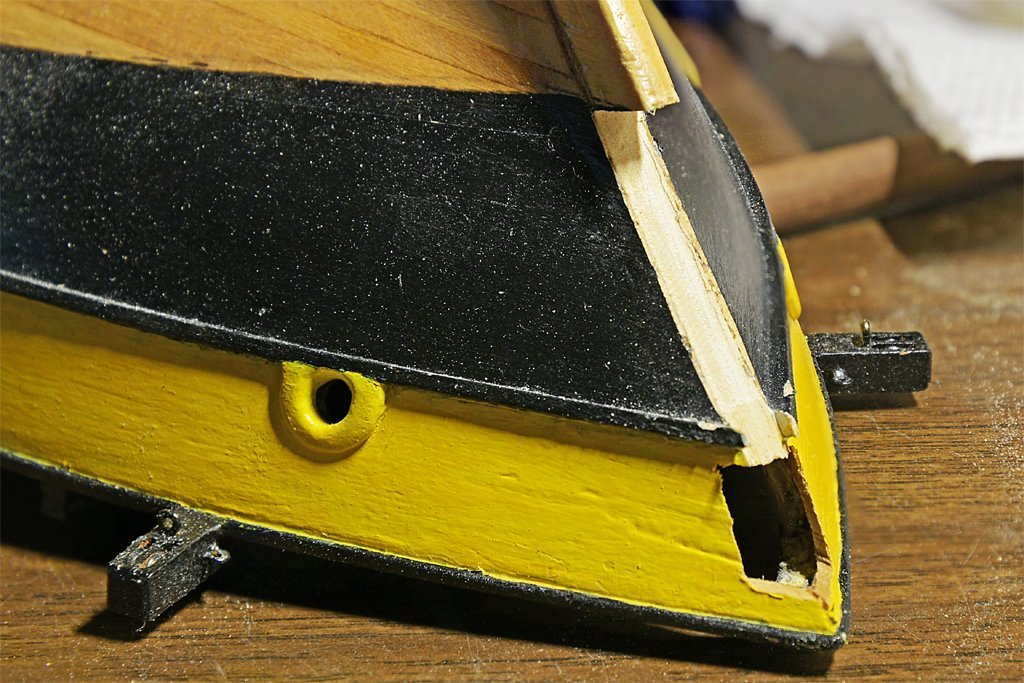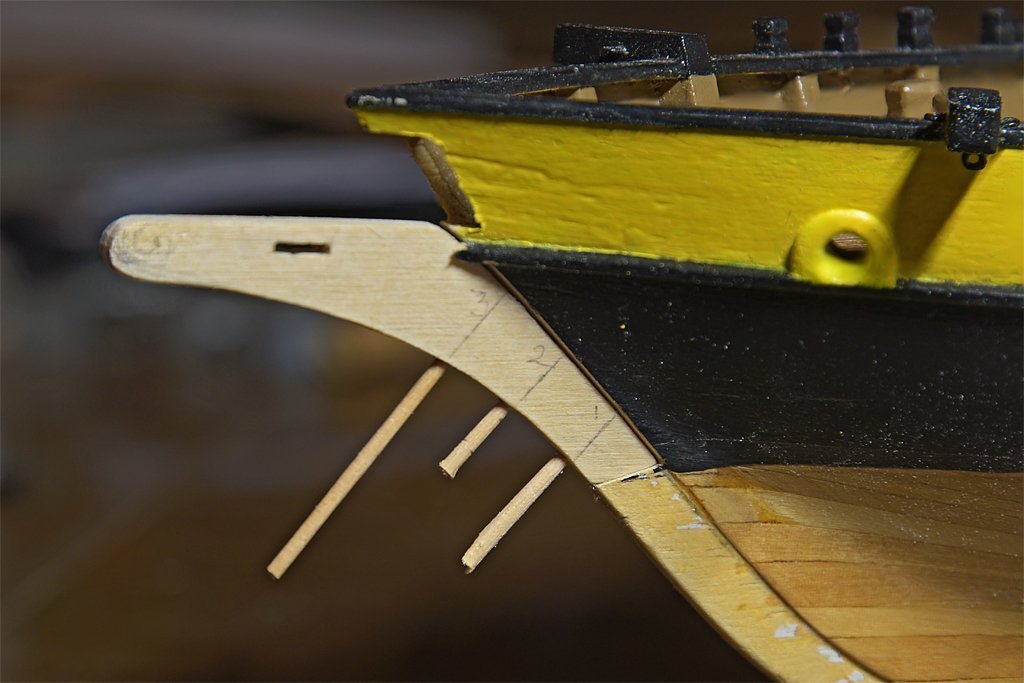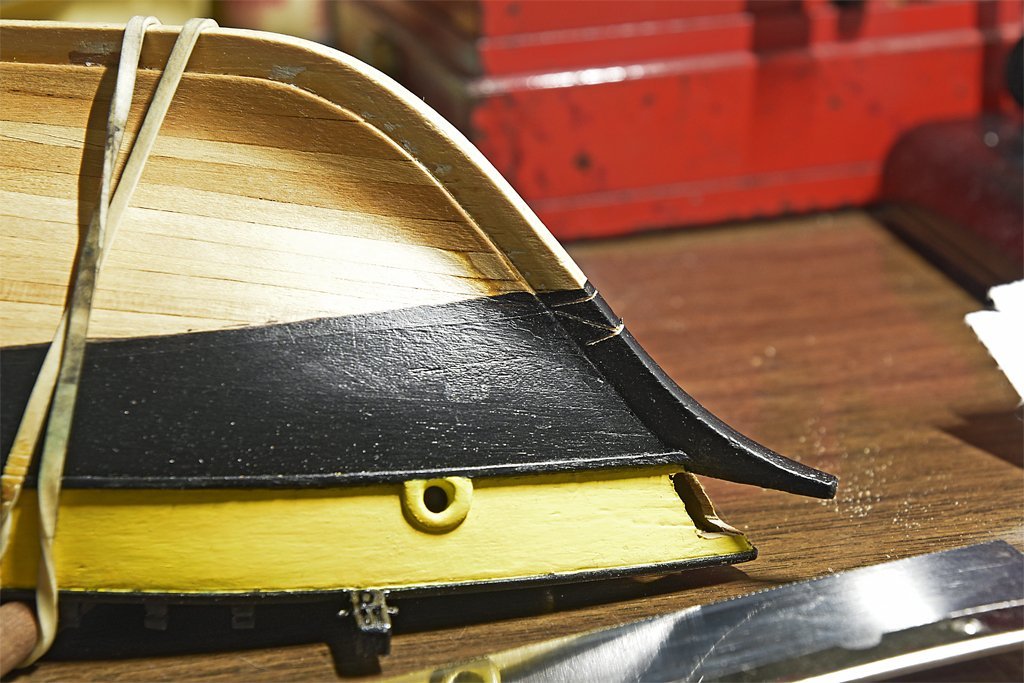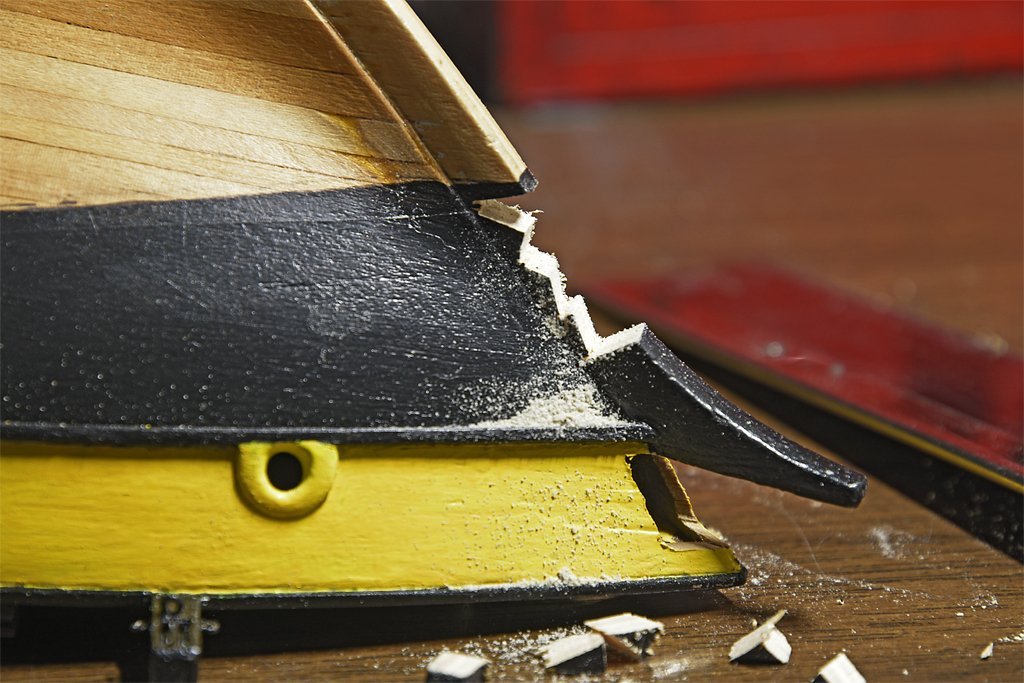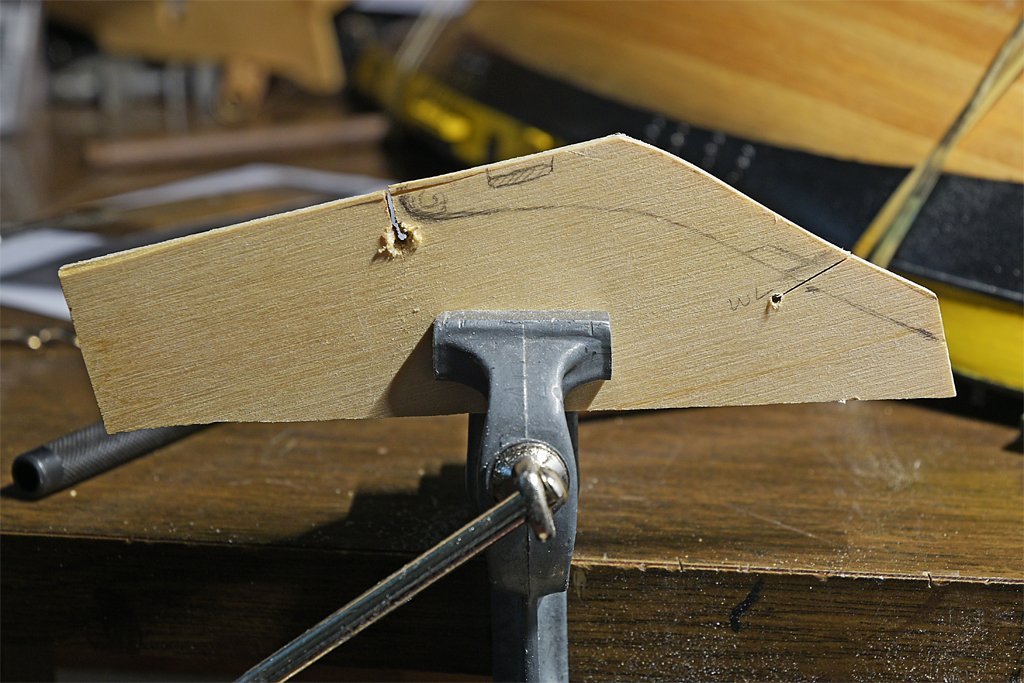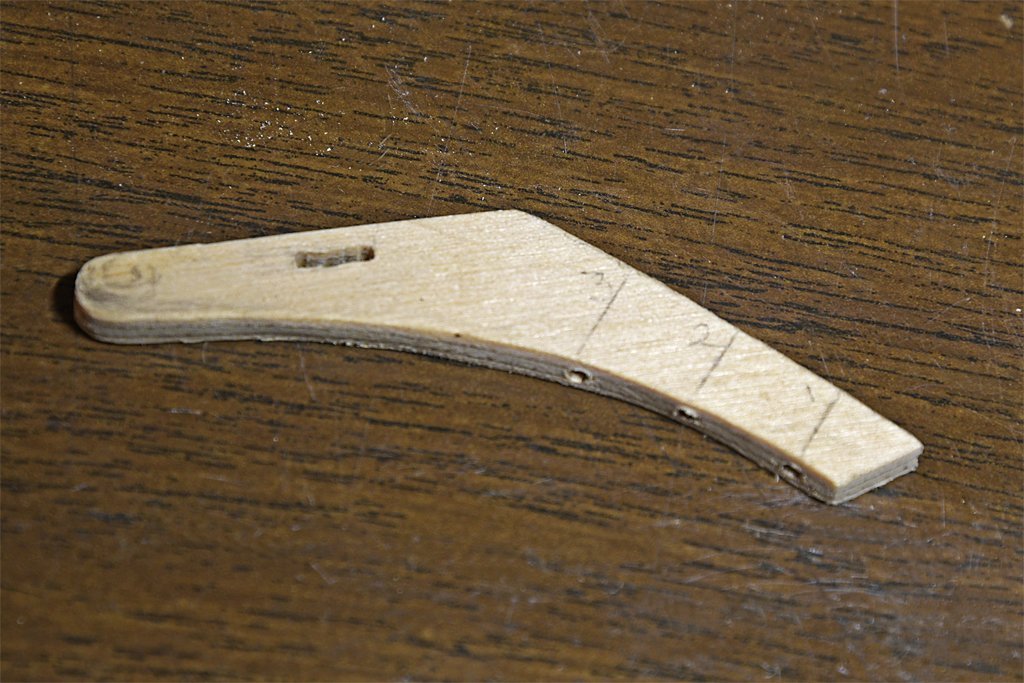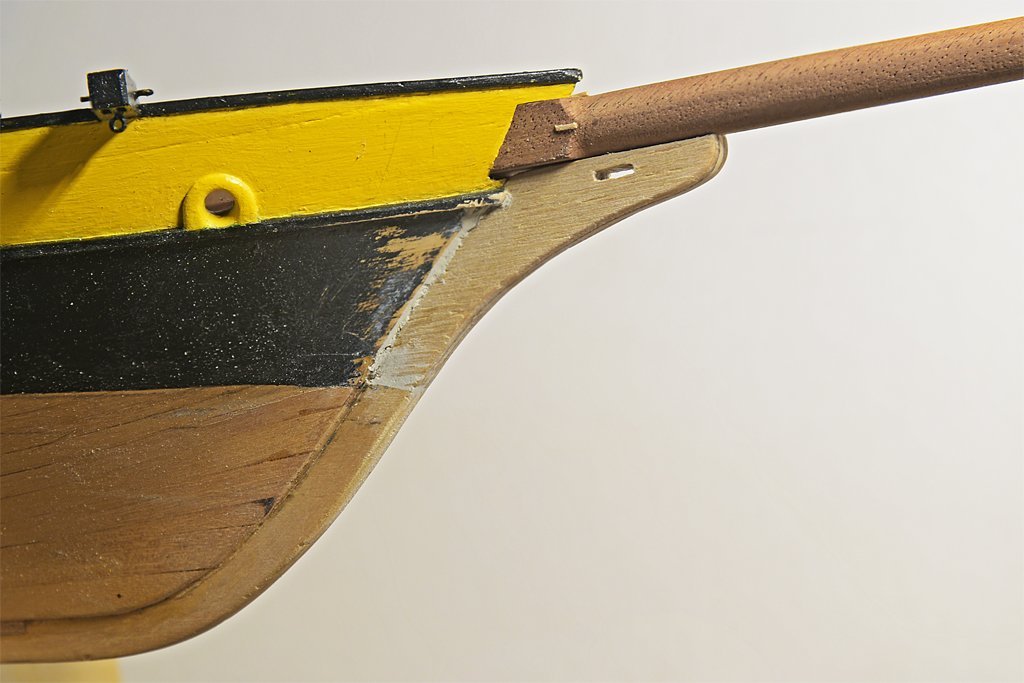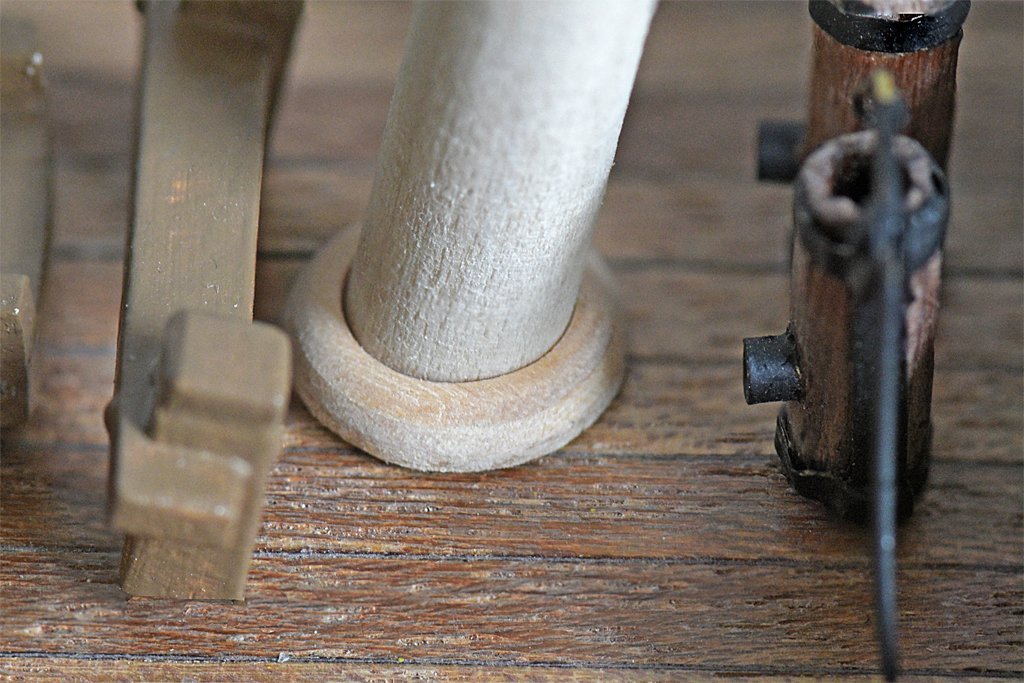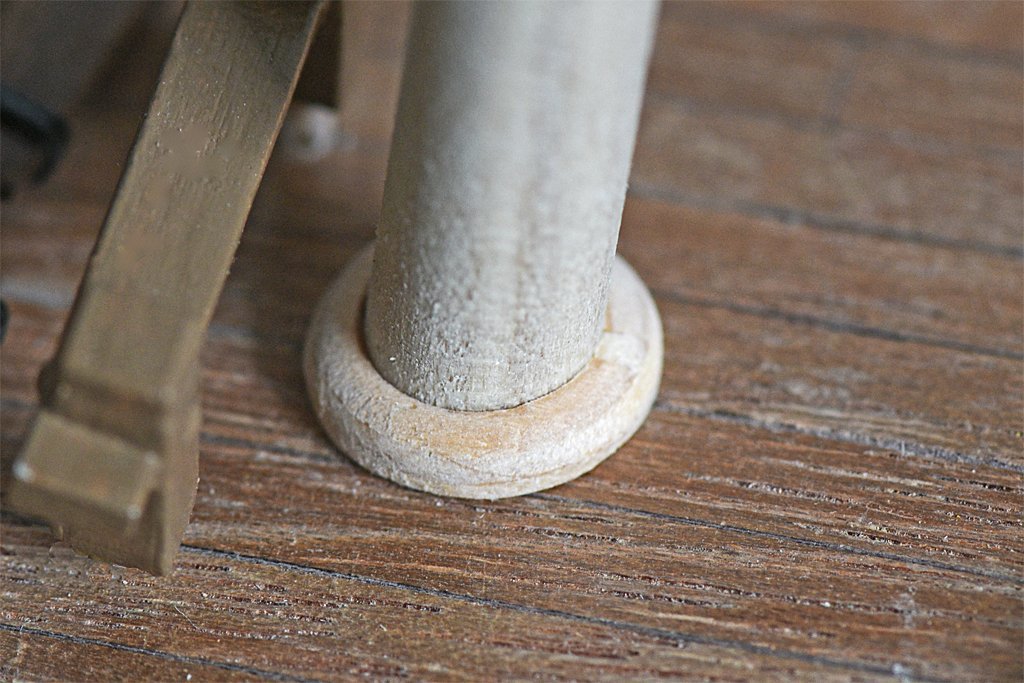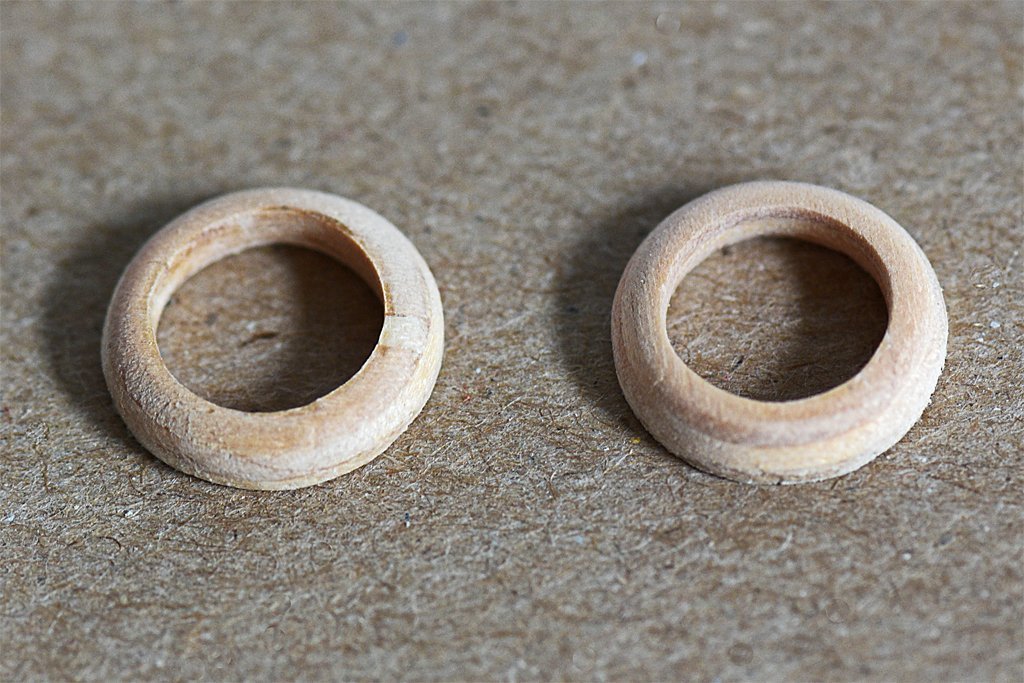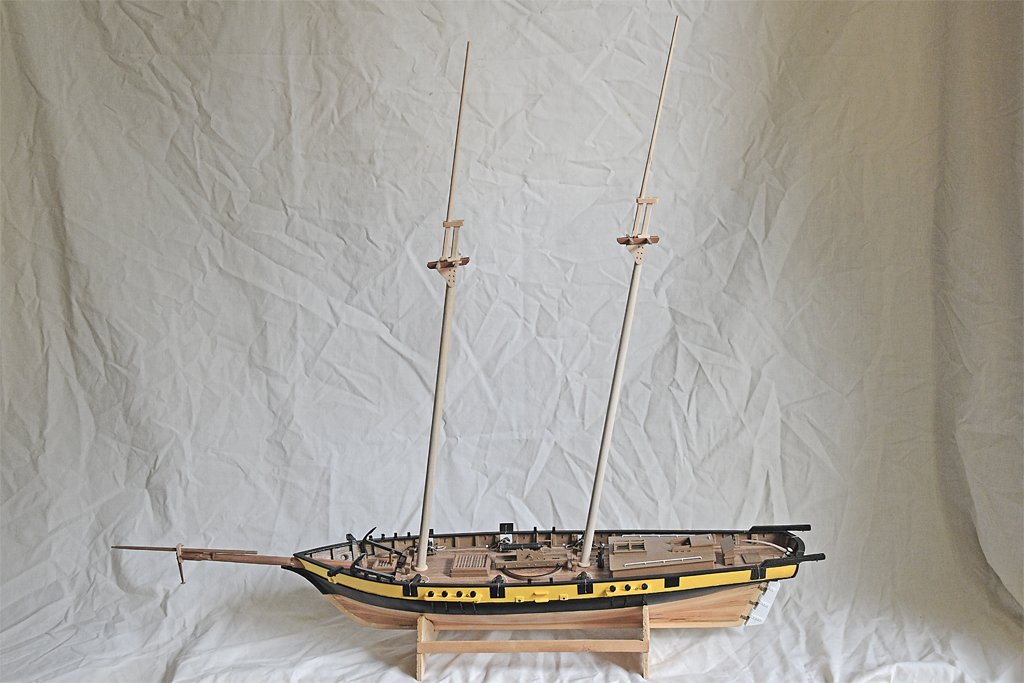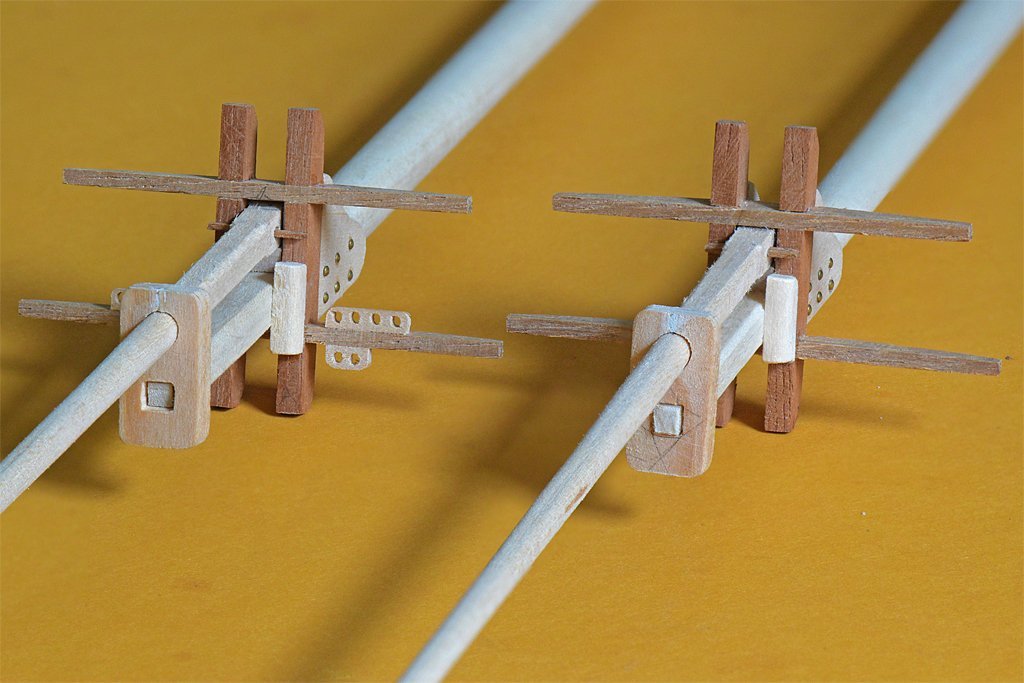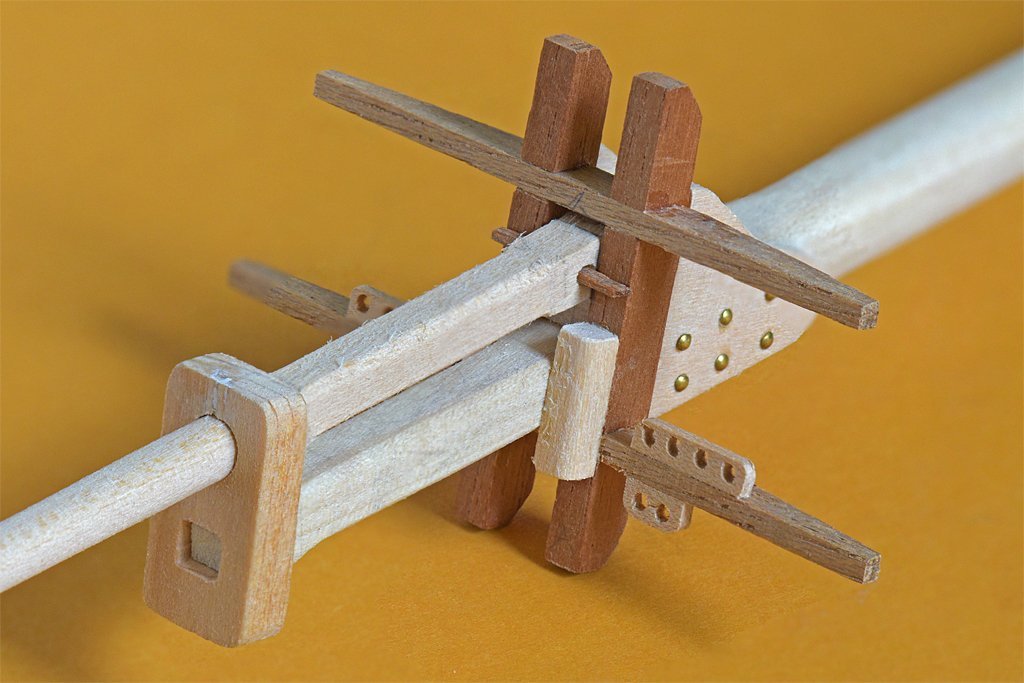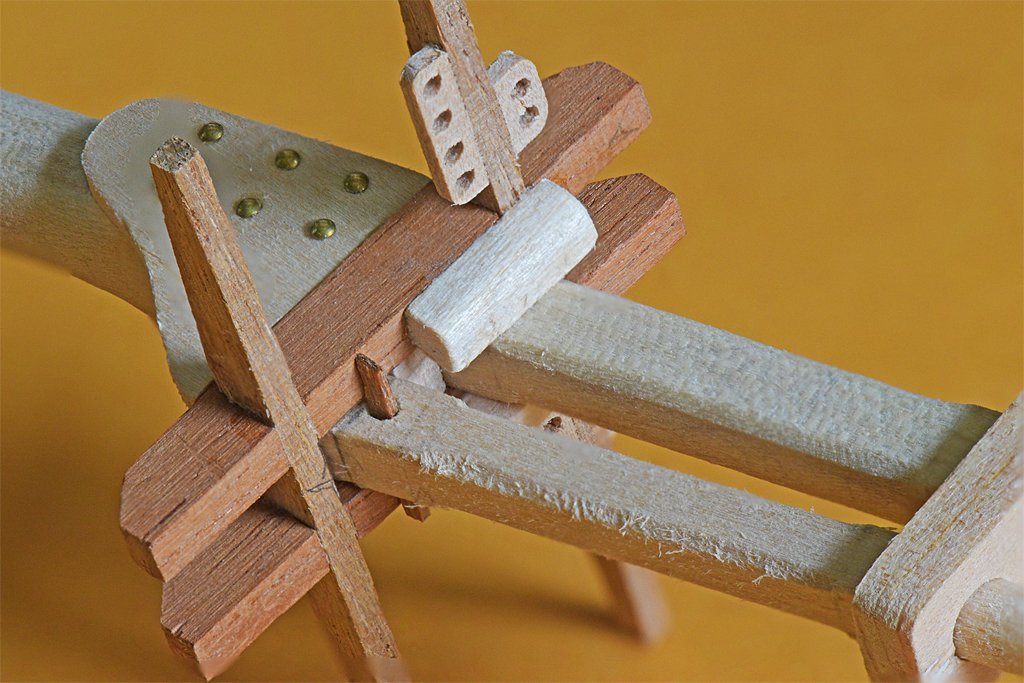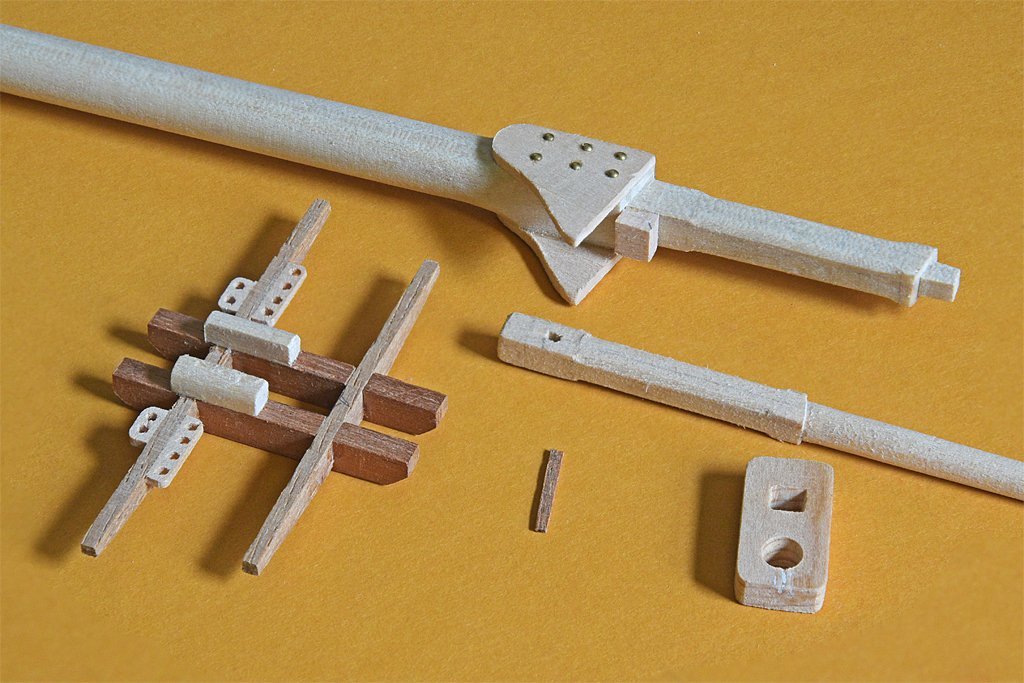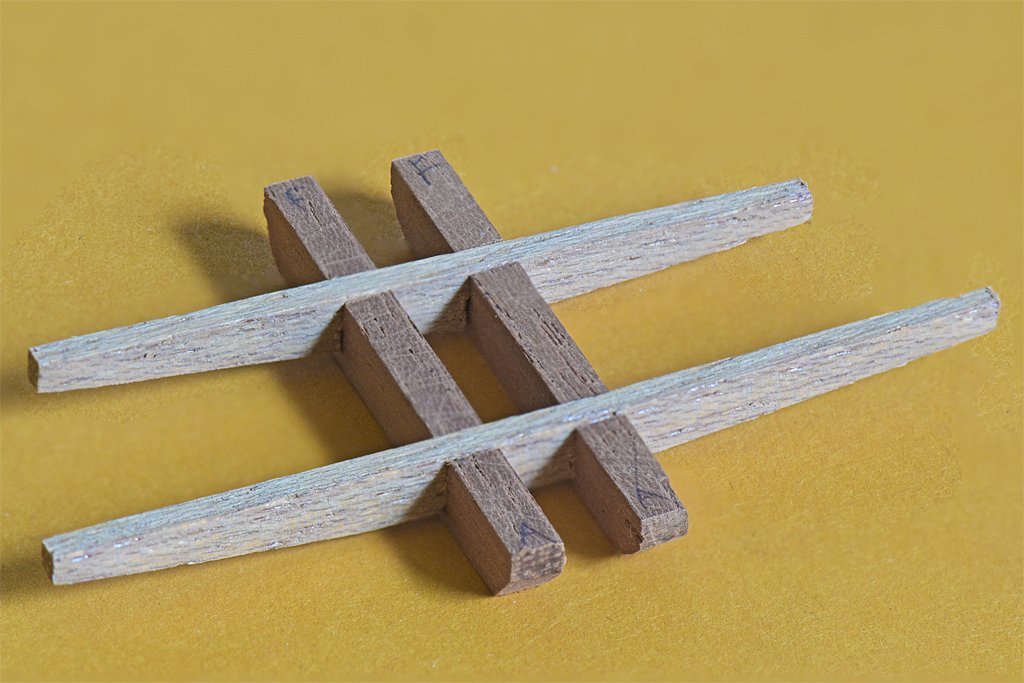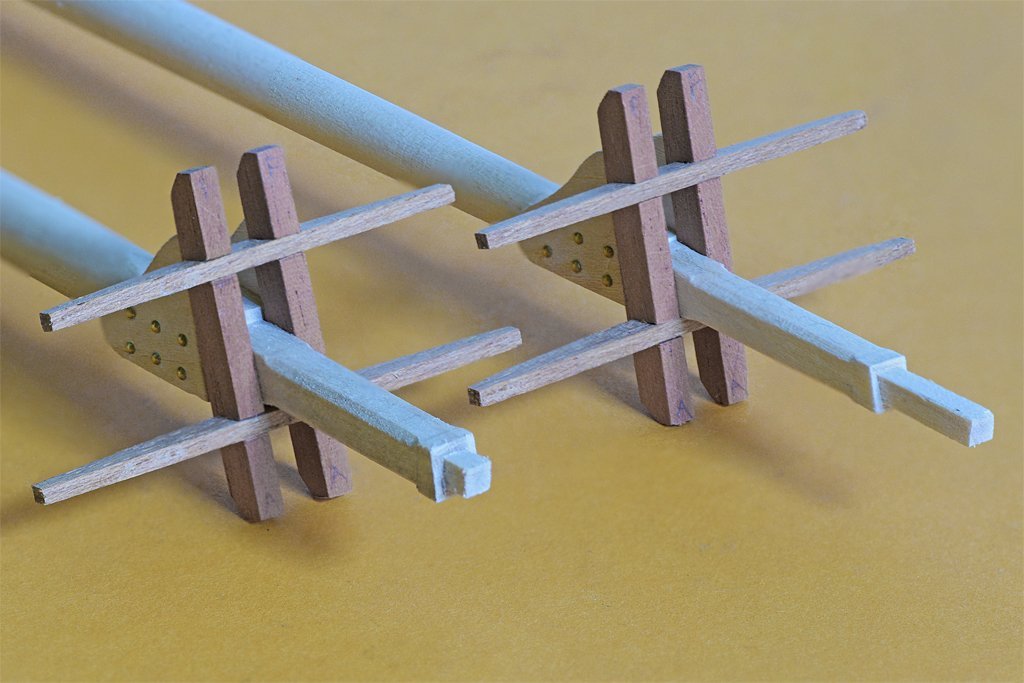-
Posts
2,451 -
Joined
-
Last visited
Content Type
Profiles
Forums
Gallery
Events
Everything posted by Dr PR
-
One way to hide the jaggies would be to cut one edge straight and put all the steps on the other edge. Then make the edge with the steps the inside edge that will be hidden by the overlapping plank. I need to make a small boat for my current build so I am watching with interest.
-
George, I have been experimenting with Minwax wood stains. I have been testing on a scrap of basswood that the masts were cut from. Since I was trying to match what I think is mahogany on the bowsprit - after it is sealed with clear shellac - I tried their red mahogany. After applying and waiting three minutes (according to instructions on the can) I wiped it off. It came out dark brown with no reddish tint, nothing like the color on the can! Then I tried Minwax cherry stain. Again the color on the can was close to what I wanted, and the instructions said I could apply multiple coats to get a darker color. However, I was careless and bought a can of their "gel stain." It is like brown jello. After applying it I had a very close match to what I wanted, but after wiping it off almost no color remained. Maybe a very, very pale hint of brown. I have applied three coats and always got exactly the same result - almost no color. So much for Minwax stains! As you night expect I am a bit frustrated. I'll look up the stains you mentioned and maybe give them a try. But right now I am just thinking of getting some acrylic paints and mixing up a suitable color.
-
Even in the modern US Navy some color schemes were the prerogative of the Captain, or even the bosun's mates. For example, on some ships the capstans, catheads or chain pipes were painted red on the port side and green on the starboard. On other ships they might be deck grey. Awnings might be grey or white, etc. On the OK City Captain Howell ran a no nonsense warship grey ship. We got a new Executive Officer who wanted to replace the grey canvas with white, with lots of frills and McNanara's lace, and paint all the plumbing a rainbow of colors. "Rodney," Captain Howell replied, "you want to turn my ship into a circus boat!" White awnings in particular were a bad idea on an oil or coal burning ship, especially if it spends time in harbor with other ships. They "blow stacks" during the mid watches to clear soot out of the smoke pipes, and the soot settles on everything. White canvas has to be scrubbed every morning by the deck crews.
-
Jim. I have been thinking about that. The bulwark brown is more of a milk chocolate color - not quite as red as the mahogany. But I guess it would make sense to use that brown for the masts and bowsprit since it was already used on the vessel. Thinking in terms of the early 1800s and what was available (cheap) at the time, if they had the brown they could use it to seal the masts and bowsprits. I have some Minwax cherrywood gel stain that I will try on a scrap of the basswood dowel to see if it comes close to the bowsprit wood with clear shellac on it. It seems to be a bit lighter than the mahogany, but the can says I can apply multiple coats to get a darker stain. I'll see how that works out. If not, I can always paint the bowsprit black.
-
Thanks George and OldSalt 1950. The repair came out OK. Now there is a place for the gammoning ropes. On some ships there was a wide gap between the knee and the bowsprit, and the gammoning was tied across horizontally in that gap. But on many schooners the bowsprit seemed to rest on the knee as shown here, so the cross tie wasn't used. For a while I considered a bit fancier knee with a bit of scrolling at the forward end. But I decided that wasn't necessary. These little revenue cutters were pretty basic, with few frills. There are many small details I have to add to the hull and deck before it is ready for rigging. But my biggest problem now is deciding how to paint the masts and bowsprit. I have created a problem for myself. I used a piece of square dowel I had on hand for the bowsprit. I think it is mahogany that I bought at our local hobby shop decades ago. It has a nice medium brown color. When I started looking for matching wood for the masts I learned you can't import mahogany into the US any more - it has almost been exterminated from the Brazilian forests. I had to settle for square basswood dowels for the masts, and you can see in the picture how much lighter they are than the bowsprit. That's poor planning! I wanted to just finish the bowsprit and masts in a natural wood color, but so far I haven't found a stain that will darken the basswood masts to match the bowsprit. The Minwax red mahogany stain is way too dark, even if it is wiped off immediately after applying. I am considering the color scheme on the modern La Recouvrance and Pride of Baltimore II schooners. The bowsprit is painted black from heel to the cap, and the jib boom is a natural wood color. The lower masts are natural wood color from the deck up to the hounds. The cheeks, trestletrees and crosstrees, mast head and cap are black. The topmast is natural wood color, with the heel black on the La Recouvrance. The spars are natural wood color, with the yardarms (tips of the spars) black. So I would lose that nice natural mahogany color on the bowsprit but I will be able to stain the masts a darker wood color than the bare basswood without trying to match the bowsprit color. And I have lots of black paint!
-
Valeriy is obviously a very experienced model maker. In addition to the clean crisp lines I am impressed that he really understands the order that the assembly needs to go together. And he doesn't forget to clean off the dust before he takes his photos!
-
I have searched through the forum for information about the color or finish on masts, mast tops and bowsprits and there are only a few posts. I thought I would create a separate topic. I am building a model of an early 1800s American Revenue Service schooner, but I am interested in painting practices on other ship types, eras and nationalities as well. I have found no historical records of the colors or finishes on revenue cutter masts. Rather, in early American vessels, including the early US Navy, there seems to be no standard color scheme. Many ship owners and captains followed British practice, but others didn't. Sometime after about 1830 it seems the US Navy did adopt a standard color scheme. Were masts and bowsprits painted or just left the natural wood color? I have seen both on modern models. I have read that some vessels had "natural wood color" masts, but the masts were greased where the mast hoops moved, and were darker as a result in these parts. If painted, what colors were common? Was the entire mast painted or only parts of it? How did this vary over time? What color was common for the tops (doubling and crosstrees)? I have seen black on some models and white on others. What periods were these colors common? Another interesting discussion was about the color of mast hoops. I read that the hoops were a different color from the masts in the British (and other) navy up to Trafalgar. Then Nelson ordered that the mast hoops be repainted to the same color as the masts so the British ships could be distinguished easily from the opposing ships. Unfortunately, the posts discussion this didn't say what the colors were for the masts and hoops before Trafalgar! All comments and discussion are welcome!
-
I performed surgery on the bow of the ship. The "knee" that projected under the bowsprit wasn't long enough or thick enough for the gammoning that was needed. Between the 1980s when this project was started and through several moves about 1/2 inch (12.5 mm) was broken off the tip. I decided it was about time to replace the knee. The amputation began with a series of saw cuts to remove material. I was a bit anxious about working on this because the plywood the stem was made of was quite old and the layers might separate. However the wood was soft and cut easily. The operation was successful and the cut area cleaned up nicely. The next step was to fashion the prosthesis out of a (relatively) new piece of plywood. I selected a piece from my scrap box and shaped one edge to fit the place on the hull. After that I used a coping saw to rough out the part. Then I used files to refine the edges to fit the hull and the bowsprit. Finally I finished shaping the part so the curves matched the curves of the hull. After cutting the hole for the gammoning rope I drilled three 1/16 inch (1.5 mm) holes through the part for wooden pegs to give strength to the joint when it was glued to the hull. I made the pegs from bamboo cooking skewers. The new knee served as the template for drilling holes in the hull for the pegs. The photo on the left shows the part temporarily pegged in place. On the right is the finished part glued in place, with some putty to fill in a few chips and create a filet where the planking met the stem. The repair is very sturdy. It looked as if the knee might be a bit too long so I took measurements from a dozen drawings in Marquardt's "The Global Schooner" and averaged the results. The length of the knee was compared with the bowsprit length from the hull planking to the bowsprit cap. The length of the knee varied from 0.17 to 0.39 times the length of the bowsprit outside the hull, with an average of 0.25. The new piece was a bit longer than average but I trimmed it back to 1/4 the length of the bowsprit outside the hull. Now I just need to seal the wood and paint the bow.
-

Off and running with the schooner rigged pond yacht
Dr PR replied to Elmina's topic in Masting, rigging and sails
Fore-and-aft rigged schooners often did not have rat lines, and the spacing between your shrouds makes it unlikely that the boat had them. Access to the upper mast was either by bosun's chair as Kieth said, or just by climbing the mast rings when the sails were set. And "bosun's chair" is a rather loosely defined term. Often it is just a rope sling that you sit on while someone hoists you up the mast. -
I have been using the free Chitubox and I am satisfied within how it works. Their tech support is pretty amazing, often responding within a few minutes to my email questions! 1. You can create custom settings for different resins and save them for future reference. 2. You can add settings for any printer - if you know them. For my Anycubic Mono I just started their Photon Workshop slicer program (not nearly as good as Chitubox) and copied the settings from it. 3. Chitubox sometimes doesn't add enough default supports and the print fails, leaving the part stuck to the FEP film. I have been manually placing supports with mostly good results. Most of the failures I am seeing are always due to not enough supports near edges and corners. If it isn't supported a surface will flex during printing and come out warped. Another related problem is supports that are too narrow at the contact point with the print part - the support doesn't connect to the printed part and is worthless. 4. Chitubox offers many options for designing individual supports, including the base shape and size, support shape and width, support end diameter, shape and depth of penetration into the surface. The only thing that doesn't seem to work correctly is cross links between supports. For me these are a nuisance, but turning them off in the settings doesn't prevent the program from adding them anyway. These can make it very difficult to remove supports from fine details. **** On another topic, I have using denatured alcohol (95% ethanol and 5% methanol). This was recommended by Anycubic for cleaning their Basic Grey resin. It is sold in gallon cans for about $18 the last time I looked - look for it in the paint stripper and wood finish products. It has always been cheaper that 95% isopropanol (isopropyl alcohol), primarily because it is available in gallon quantities. **** And now a question: I read in someone's post that they used hot water or a heat gun to soften warped pieces and then bend them back into shape. Has anyone tried this? Do you heat the part before curing or after? The single greatest frustration I have found with 3D printing is that thin details like hand rails are often distorted by the forces of separating the print from the FEP and then pressures from resin flow as the part returns to print the next layer. These parts are always bent between the supports, and often come out "fat" in between supports. So far this problem has made 3D printing useless for many of the things I have tried to make. If I can reshape the warped railings and pipes after printing there are a lot more things I could use 3D printing for.
-

Off and running with the schooner rigged pond yacht
Dr PR replied to Elmina's topic in Masting, rigging and sails
Belaying plans (where the rigging tied off on deck) are rarely found for ships because everyone knew how to do it and didn't need a plan. The fore-and-aft schooner rig was pretty simple (compared to a square rigged ship). Normally there would be pin rails along the bulwarks along the sides of the hull (but your model doesn't have bulwarks) and the fife rails at the base of the masts. Lines could also belay to ring bolts in the deck at the base of the masts and along bulwarks and cleats near the bottom of the masts and on the bulwarks. The general rules for belaying the running rigging were: 1. Lines from lower on the mast would go to the more forward belaying points and lines from higher on the mast would go to belaying points more aft on the rails. This makes sense because masts often had rakes leaning aft so the origins for lines higher on the mast would be more aft than those lower down. A few vessels had forward raking fore masts so the rule would be reversed in this case. 2. Lines originating on or close to the masts led down to the base of the mast, and lines originating nearer the ends of spars (square rigged) would lead down to pin rails, cleats or ring bolts on or near the bulwarks. On some vessels lines from the higher parts on the masts were belayed to points on the bulwarks or along the sides of the deck. 3. Lines must run free without touching other lines (or anything else). If ropes rubbed against something they would chafe and this could lead to the line parting. At sea the ship pitched and rolled and everything aloft was in motion. Even in port the winds and tides caused the ship to move. If a line rubbed against anything else it would cause wear on the line and whatever it touched - even a sail. Where lines must touch something else they were wrapped in chafing gear (wraps of canvas and/or rope) that was supposed to take the wear. The idea behind these rules was to prevent lines from crossing and getting tangled with one another. Since there is no original belaying plan for your model you can rig it just about any way you want. Keep these rules in mind and you can't go wrong in rigging the model. -
I enlarged the mounting holes in the deck and installed the masts (temporarily). I made the mast coats to fit around the bases of the masts. These things were quite a challenge! They are 0.5 inch (12.7 mm) diameter. I figured if I tried to make them from an ordinary sheet of wood they would break apart while I was shaping them. So I decided to use 1/8 inch (3.2mm) plywood, hoping the cross grains would hold them together. I picked a piece out of my scrap box, and I have no idea how old it was. But in hindsight it could have been left over from a kit from the 1960s. That stuff wasn't very good plywood to begin with, and the glue they used to hold the laminations together was pretty poor. I think the wood was holding the glue together. Again and again pieces of the outer layers chipped off and I had to recover them and glue (Duco Cement) them back on. In some cases the pieces went to never never land and I had to strip a bit of a layer from scrap plywood, shape it and glue it in place. You can see one of these patches in the left hand part. But as you can see I eventually got the parts shaped suitably. I will seal them and paint with the same brown as the bulwarks.
-

Problem creating new posts
Dr PR replied to Dr PR's topic in Using the MSW forum - **NO MODELING CONTENT IN THIS SUB-FORUM**
I can't delete all cookies (too many bank account logins, IRS and other government links, plus forums and other sites that I use regularly) but I just went through the very long list and deleted most of them. I just made a test post on the Albatros thread and it worked. It was very strange that the problem was only on that single thread. Thanks. -
Recently I have been having a problem creating new additions to my Albatros thread. When I click in the "Reply" box nothing I type appears there. Instead the "Drag files here to attach ..." is all I see. I have tried saving the new entry and opening it again, but all I see is the "drag files ..." box. The only way I have been able to start a new entry is to load some pictures and select one. After this I can add text after the photo, but there seems to be no way to go to the start of the post. So I save the new post, open it again, add text after the picture and then delete the picture. This puts my text at the start of the post. After this I can add more text and pictures. This started happening about a week ago and has happened several times now. I do not have a problem adding new posts in other threads on the Forum.
-
Here is a bit more progress. I have made all of the wooden parts of the mast tops and trimmed everything to fit. All parts need sealer and sanding. Above the cheeks on the mast head is a spacer block that is a rest for the topmast heel. The crosstree assembly has the bolsters and guides for topmast rigging. The topmast stays will be rigged to the ends of the crosstrees. The topmast lower part has been shaped and has the fid hole - the fid is the small piece of wood. The mast cap has a snug fit on the top of the lower mast tenon and a loose fit for the topmast. The parts of the fore top are shown on the left. The main mast (right) doesn't have a square topsail so the rigging is much simpler and the guides for the rigging aren't needed. The topmast slips into the crosstree assembly from below and then passes through the hole in the top. After the mast is full up the fid is inserted to hold it in place. This is how the real topmasts worked. I haven't cut the slot for the sheave for the uphaul rope. Also missing are bunch of ring bolts for all the stays and tackles that attached to the tops. I should have created a 3D CAD model before moving on to cutting wood. There are a couple of less than perfect parts. The bolsters are too beefy. This is basically because the trestletrees are probably a bit too wide, but they are still within the extreme ranges of the calculations mentioned a few posts above. I think I will file the bolsters to remove some material from the tops. The other problem is the position of the guides for the topmast rigging on the fore mast. These allow routing the topsail running rigging clear of other rigging to ensure the lines do not foul other rigging. The guides are very close to the trestletrees, and the lower mast shrouds have to pass between them and the trestletrees. Fortunately there aren't a lot of shrouds (three per side on the fore mast plus the fore tackle/burtoning tackle. The clearances between the shrouds and running rigging looked good on the 2D drawings. I may have to move the guides, and that could be tricky. I was surprised that I could make the tiny pieces without them breaking apart when I drilled the holes. The holes are 0.057 inch (1.4 mm) diameter on 0.1 inch (2.54 mm) spacing.
-
Dave, I am kit bashing a 1980s topsail schooner. The kit plans did not include a lot of the rigging on an actual ship - it was a simplified rigging plan. After I started doing research on these ships I realized I would not have enough blocks for the additional rigging. In addition, the kit supplied thread was pretty fuzzy and there were only two or three sizes. Neither the "ropes" nor blocks were to scale. When I started looking at the way rope sizes were calculated I learned that block sizes are determined by rope sizes. All this led me to decide to replace all the ropes and blocks. This wasn't so much to make a "correct" model because what I am building if a fictitious ship anyway. But I wanted the experience of creating a true to scale rigging on the model. I bought rope and blocks from Syren and the cost came out to about $270. That's quite a bit more than I paid for the kit! But Chuck's products are very nice. Keep this cost in mind. The topsail schooner has square sails on the fore mast only, and there are only two masts. The Rattlesnake has a LOT more rigging. I haven't tried to figure that out yet for the Rattlesnake kit I have, but I'll bet there are 5 to 10 times as many blocks as the simple schooner rig, and a lot more rope. You can use much of the material in the kit even if it isn't the best quality. But some pieces are just stock items the company had on the shelf and are either out of scale or just inappropriate for the vessel and period you are modeling. So for these parts you might want to make substitutions. But in the end it all boils down to asking yourself what you want to build.
-
For what it is worth, a wooden minesweeper I served on had an inner layer of diagonal planking with an outer layer of traditional longitudinal planking. It produced a strong hull without any (magnetic) metal parts.
- 454 replies
-
- Union Steamship Company
- Stepcraft 840
-
(and 3 more)
Tagged with:
-
After all that fuss I made the tops according to my original plan with a few minor tweaks to fit the masts. Since the top masts are the same on both fore and main masts the tops are also the same. There are few additions I will make before finishing them - bolsters and such. The wood is pretty grainy so I need to seal with sanding sealer or maybe shellac. The tops will be painted so the different colors of the wood won't matter.
-
I decided to take all of the conflicting dimensions for trestletrees and crosstrees and average them to get values for my model. That is how I determined the mast dimensions that I am using. Here are all of the "rules": Trestletree Dimensions Cock: Length = 5 x diameter of mast at hounds Height = ½ diameter of mast at hounds Width = 1/3 diameter of mast at hounds Trestletrees are bolted through the mast with 2 bolts and are centered on the lower mast. Hedderwick: Size = 7/8 diameter of mast at partners (not less than ¾) Length = 5 ½ to 6 times diameter of mast OR ½ breadth of top Height = 5/6 diameter of mast at hounds Width = 3/7 of the trestletree height Kipling: Length = top length fore and aft = 2/3 to ½ top width Height = ½ diameter of mast at partners Width = ½ trestletree height Top width = 1/2 molded beam Chapman: Height (inches) = topmast length (feet)/4 – ½ inch Width = 5/7 trestletree height Mondfeld: Length = 0.3 to 0.35 beam Height = 0.08 x trestletree length Width = 0.9 x trestletree height Lees: Length = 3 ¾ inch per yard of topmast length (0.104 times topmast length) Height = 1 inch per foot length (1/12 length or 0.083 times length)) Width = 2/3 trestletree height Lower tops width (transverse) = 1/3 length of topmast. Length (longitudinal) 3/4 top width. Marquardt: Length = 3 ½ inch for every yard of topmast length (0.097 times topmast length) Height = 1 1/8 inch for every foot trestletree length (0.094 times length) Width = 2/3 trestletree height Crosstree DImensions Cock: Length = (11/12 x beam)/2 Height = ½ trestletree height/depth Width = same as trestletree breadth/width Hedderwick: Length = breadth of top = 5/9 beam Height = 5/6 trestletree height Width = 3/7 crosstree height Kipling: Length = width of top = ½ molded beam Height = same as trestletree height = ½ diameter of mast at partners Width = 2/3 crosstree height Chapman: Height = 3/7 trestletree height Width = ¾ crosstree height Anderson: (for circular top trestletree length = crosstree length) Length= masthead length or a little more Height = 1/13 trestletree length Width = 7/8 or 9/10 trestletree height He cites other references that say the length should be 1/3 the beam, ranging from 0.36 to 0.25 times the beam for smaller ships Lees: Length = 1 2/3 times length of trestletree Height = 7/8 x height of trestletree Width = same as trestletree (2/3 trestletree height) Marquardt: Length = 1 1/3 trestletree length Height = 7/8 trestletree height Width = 1 ¼ trestletree width References: Anderson, R. C., “Seventeenth Century Rigging,” 1955 Chapman, Frederick, “Treatis of Shipbuilding,” 1820 (Archetectura Navalis Mercatoria) Cock, John, “A Treatise on Mast Making,” 1840 Hedderwick, Peter, “A Treatise on Marine Architecture,” 1830 Kipling, Robert, “Rudimentary Treatise on Masting, Mastmaking and Rigging,” 1864 Lees, James, “The Masting and Rigging of English Ships of War,”1979 Marquardt, Karl, “The Global Schooner,” 2003 Mondfeld, Wolfram, “Historic Ship Models,” 1989 I think the large differences for some of the results are caused by some of the authors giving rules for tops with platforms, where the trestletrees will be much longer than for tops without platforms. Other than those numbers all of the calculations gave values that were pretty close to each other. After averaging the results from all of these calculations - excluding those results that were 2X or more than the other values - I found that the dimensions in my original drawings fell within the range of values from the calculations. So I will go with what I already came up with.
-

USS MAINE by steven. R - sheet metal
Dr PR replied to steven. R's topic in - Build logs for subjects built 1901 - Present Day
The USS Maine story is an interesting one. It wasn't the US government that blew it up into an excuse for a war. It was the Hurst newspaper chain - perhaps the best example of "yellow journalism." It was a tragedy, and subsequent studies have failed to give a definitive cause for the explosion, but some possible causes have been determined. But the Hurst chain blew the story up into tremendous hyperbole to sell more newspapers. They blamed the Spanish and editorialized that the US should go to war. Not much (any?) of what they said was true, but they got their war, sold a lot of papers and got rich. Unfortunately, our current trends in "news" reporting isn't much different from Hurst's yellow journalism. The goal is to make money, and news reporting has become infotainment, with different sources slanting the stories to appeal to some particular bunch of suckers. Just a bunch of talking heads reading the appropriate propaganda. George Orwell's fantasy has come true. Truth is lies. Ignorance is strength. -
That formula is very useful - I hadn't tried to calculate it myself. arctan(layer height/pixel width) Use the same units (inch, millimeter, whatever) for both layer height and pixel width. The videos assume that most people print at a 0.05 mm slice thickness, and that is common. But you can improve surface smoothness by using thinner slices. My Photon Mono will print 0.01 mm slices and this makes much smoother horizontal surfaces. But As I noted in my earlier post, layer/slice thickness has no effect for angles greater than 45 degrees - for these surfaces pixel size is the limit. Chitubox allows several antialiasing settings (Anti-aliasing Level, Grey Level and Image Blur Pixel). These settings cause the "jaggies: to be filled in partially, significantly reducing the effect. With the proper print angle and adequate antialiasing settings you can get surfaces that are so smooth that you need a magnifier to see any roughness, and then it may only be visible as a slight light pattern on the surface.
-
The "ideal" angle of 45 degrees is for prints with the vertical step (slice) thickness equal to the horizontal pixel size. This will generate the smallest "jaggies" but also the most of them. Steeper vertical angles produce jaggies that are the pixel size but a lot fewer of them. At angles less than 45 degrees the jaggies size is dependent upon slice thickness and the number is dependent upon the pixels in the slice. I posted some drawings and photos in post #173 in this thread that illustrate these effects and discussed how to minimize them.
About us
Modelshipworld - Advancing Ship Modeling through Research
SSL Secured
Your security is important for us so this Website is SSL-Secured
NRG Mailing Address
Nautical Research Guild
237 South Lincoln Street
Westmont IL, 60559-1917
Model Ship World ® and the MSW logo are Registered Trademarks, and belong to the Nautical Research Guild (United States Patent and Trademark Office: No. 6,929,264 & No. 6,929,274, registered Dec. 20, 2022)
Helpful Links
About the NRG
If you enjoy building ship models that are historically accurate as well as beautiful, then The Nautical Research Guild (NRG) is just right for you.
The Guild is a non-profit educational organization whose mission is to “Advance Ship Modeling Through Research”. We provide support to our members in their efforts to raise the quality of their model ships.
The Nautical Research Guild has published our world-renowned quarterly magazine, The Nautical Research Journal, since 1955. The pages of the Journal are full of articles by accomplished ship modelers who show you how they create those exquisite details on their models, and by maritime historians who show you the correct details to build. The Journal is available in both print and digital editions. Go to the NRG web site (www.thenrg.org) to download a complimentary digital copy of the Journal. The NRG also publishes plan sets, books and compilations of back issues of the Journal and the former Ships in Scale and Model Ship Builder magazines.



